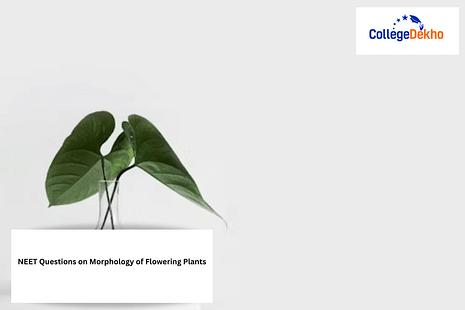NEET Questions on the Morphology of Flowering Plants will consist of questions from parts of flowers, plant types, root systems, leaves, stems, fruits & seeds and so on.

NEET Questions on the Morphology of Flowering Plants consists of questions from topics like plant types, root systems, leaves, stems, fruits & seeds and so on. Students will be able to understand the chapter better if they solve questions from NEET 2024 Questions on the Morphology of Flowering Plants.
The
NEET exam
biology chapter teaches students about the flower parts, structures and forms. It talks about the external structures of flowers and their forms. It provides knowledge about various plant parts such as roots, stems, leaves, fruits and flowers. It also gives insights on plant reproduction, classification and adaptation. Further, it also teaches the students about the plant characterization of plant organs, their functions and their relationship to one another, plant taxonomy etc. In this article, know in detail about the NEET EET Questions on the Morphology of Flowering Plants 2024 and more.
List of NEET Questions on the Morphology of Flowering Plants
There are some important topics that students must study like plant types, plant families, seeds, leaves, stems etc that students must study during their biology paper preparations. Below is the list of NEET questions on the Morphology of Flowering Plants.
1. Which of the following tissues is responsible for water and mineral transport in plants?
a. Epidermal tissue
b. Parenchyma tissue
c. Collenchyma tissue
d. Vascular tissue
Answer: d. Vascular tissue
2. Which of the given is not a type of simple permanent tissue?
a. Parenchyma tissue
b. Collenchyma tissue
c. Sclerenchyma tissue
d. Xylem tissue
Answer: d. Xylem tissue
3. In a typical dicot stem, which of the mentioned tissues is present between the phloem & the pith?
- a. Cortex
- b. Cambium
- c. Endodermis
- d. Pericycle
Answer: a. Cortex
4. Which of the given is not a function of the root system in plants?
- a. Anchorage
- b. Absorption of water and minerals
- c. Photosynthesis
- d. Storage of food
Answer: c. Photosynthesis
5. Which of the mentioned is not a characteristic of monocot plants?
- a. Parallel venation in leaves
- b. Scattered vascular bundles in stem
- c. Fibrous root system
- d. Two cotyledons in seeds
Answer: d. Two cotyledons in seeds
6. In a typical leaf, which of the mentioned is not a function of the epidermal tissue?
- a. Protection
- b. Secretion
- c. Gas exchange
- d. Absorption
Answer: b. Secretion
7. Which of the stated is not a type of meristem tissue?
- a. Apical meristem
- b. Lateral meristem
- c. Intercalary meristem
- d. Vascular meristem
Answer: d. Vascular meristem
8. Which of the options is not a function of the stem in plants?
- a. Support
- b. Photosynthesis
- c. Conduction of water and minerals
- d. Storage of food
Answer: b. Photosynthesis
9. The arrangement of leaves on a stem is termed as:
- a. Venation
- b. Phyllotaxy
- c. Internode
- d. Stolon
Answer: b. Phyllotaxy
10 Which of the given is a characteristic feature of gymnosperms?
- a. Naked seeds
- b. Flowers
- c. Fruits
- d. Vascular tissue
Answer: a. Naked seeds
11. The primary function of the root cap in a plant is called as:
- a. Absorption of water and minerals
- b. Anchoring the plant in the soil
- c. Protection of the root tip during growth
- d. Photosynthesis
Answer: c. Protection of the root tip during growth
12. The root system type found in most dicot plants is called:
- a. Taproot system
- b. Fibrous root system
- c. Adventitious root system
- d. Prop root system
Answer: a. Taproot system
13. In dicot stems the vascular bundles are rowed in a:
- a. Ring
- b. Scattered pattern
- c. Concentric circle
- d. None of the above
Answer: a. Ring
14. Which of the given plant parts develops from the ovule after fertilization?
- a. Seed
- b. Fruit
- c. Flower
- d. Root
Answer: a. Seed
15. In monocot leaves, the arrangement of vascular bundles is called:
- a. Scattered
- b. Parallel
- c. Netted
- d. Whorled
Answer: b. Parallel
16. The modified leaf that protects the flower in its bud stage is said as:
- a. Sepal
- b. Petal
- c. Stamen
- d. Carpel
Answer: a. Sepal
17. Which part of the plant contains pollen grains:
- a. Sepal
- b. Petal
- c. Stamen
- d. Carpel
Answer: c. Stamen
18. In a typical flower, what is the female reproductive part called:
- a. Sepal
- b. Petal
- c. Stamen
- d. Carpel
Answer: d. Carpel
19. The condition of having both male and female reproductive organs in one flower is called:
- a. Dioecious
- b. Monoecious
- c. Perfect
- d. Imperfect
Answer: c. Perfect
20. The swollen base part of the pistil where ovules are found is called the:
- a. Stigma
- b. Style
- c. Ovary
- d. Filament
Answer: c. Ovary
NEET 2024 Questions on the Morphology of Flowering Plants with Explanation
Students can go through the NEET 2024 Questions on the Morphology of Flowering Plants with Explanation stated below.
Q 1. Which of the following are examples of axial placentation:
- China Rose, Petunia, and Lemon
- Mustard, Cucumber, and Primrose
- Chine rose, Beans, and Lupin
- Tomato, Dianthus, and Pea
Answer: d. Tomato, Dianthus, and Pea.
Explanation: Axile placentation refers to the arrangement of ovules within an ovary where the ovules are attached to the central column. This placentation type is observed in certain plant species. Among the options provided, dianthus (a genus that consists of carnations), tomato and pea (legume family member) depict axile placentation.
Q 2. In Calotropis, aestivation is called:
- Valvate
- Vexillary
- Imbricate
- Twisted
Answer: c, Imbricate
Explanation: Imbricate – Calotropis has imbricate aestivation, where there is a regular overlapping in the stems and petals.
Q 3. Roots growing vertically upwards like conical spikes and having aerating pores are called
- Mycorrhizal
- Assimilatory
- Pneumatophores
- Conical
Answer: c, Pneumatophores
Explanation: Pneumatophores are roots that grow up vertically and have aerial pores, this allows them to absorb more oxygen from the air compared to other plants. They commonly grow in marshy habitats or areas with shallow water where they can support the plant.
Q 4. A form of the underground stem containing a food reserve that is short and vertical is called
- Corm
- Rhizome
- Tuber
- Bulb
Answer: a. Corm
Explanation: A corm is a form of underground stem that serves as a storage organ for food reserves in the plant body. It is short & vertical, with a swollen base which contains nutrients. Corms in plants such as gladiolus, crocus, & taro are typically rounded or oval-shaped.
Q 5. In Bougainville, thorns are the modified versions of
- stipules
- leaf
- stem
- adventitious root
Answer: c, stem
Explanation: In Bougainville, thorns are the modified versions of the stem. Thorns are sharp, pointed structures that grow from various parts of the plant. For the Bougainville Plant, the thorns are modified stems. These modified stems are often hardened and act as a protection for the plants. Thorns can also act as a defence mechanism against herbivores.
Q 6. Indigofera, Sesbania, Salvia, Allium, Aloe, Mustard, radishes, chickpeas, and turnips have stamens of ______ different lengths of the flower.
- Six
- Five
- Four
- Three
Answer: a, Six
Explanation: Each plant consists of a minimum of two kinds of stamens that are different in size. The various length of stamens is an example of one of the morphological characteristics that can be used to distinguish between flowering plant species.
Q 7. Which of the following is not a stem modification?
- Thorns of citrus
- Pitcher of Nepenthes
- Flattened structures of Opuntia
- Tendrils of cucumber
Answer: b, Pitcher of Nepenthes
Explanation: Pitcher of Nepenthes is an adaptation to capture insects & not a stem modification.
Q 8. In the cymose type of inflorescence in a plant which of the phenomena happens:
- The main axis continues to grow & the flowers are borne in acropetal succession.
- The main axis continues to grow and the flowers are borne in basipetal succession.
- Growth is limited & the flowers are borne in basipetal succession.
- Growth is limited & the flowers are borne in acropetal succession.
Answer: a. The main axis continues to grow & the flowers are borne in acropetal succession.
Explanation: In a cymose type of inflorescence, the growth is usually limited & the flowers are borne in acropetal succession. This often means that the main axis of the inflorescence terminates in a flower, and subsequent flowers grow in a basipetal (downward) sequence, with the youngest flowers situated at the top & the oldest ones at the bottom. The growth of the main axis is restricted, often resulting in a determinate inflorescence pattern.
Q 9. Which of the following is correctly associated with its three characteristics?
- Maize: C3 pathway, closed vascular bundles, scutellum
- Onion: bulb, imbricate aestivation, axile placentation
- Tomato: twisted aestivation, axile placentation, berry
- Pea: C3 pathway, endospermic seed, vexillary aestivation
Answer: a. Maize: C3 pathway, closed vascular bundles, scutellum
Explanation: Maize plant follows the C4 pathway for carbon fixation, not the C3 pathway. Additionally, the vascular bundles in the maize plant are open, not closed.
Q 10. Which of the following is a xerophyte where the stems vary in flat green colour and are of juicy structure?
- Acacia
- Hydrrilla
- Casuarina
- Opuntia
Answer: d.Opuntia
Explanation: The Opuntia plant is a xerophytic plant whose stem transforms into a flat, green structure, these types of stems are called cladodes. Opuntia, also known as prickly pear or cactus, has flattened green stems which are termed cladodes that are succulent & green. These modified stems allow the plant to survive in arid environments by storing water in themselves.
Q 11. “Often Plants growing in swamps have roots that grow vertically upwards like conical spikes and have aerating pores”. What are such roots called?
- pneumatophores
- mycorrhizal
- conical
- assimilatory
Answer: a. Pneumatophores
Explanation: The plant's roots growing in swamps grow vertically upwards like conical spikes and have aerating pores. These types of roots are roots are called pneumatophores & they allow the plant to take in oxygen even from water-logged soils. They often act as stilts for support when the water level rises & provide stability to the growing plants.
Q 12. The parasitic plant Cuscuta roots are of
- climbing
- prop or stilt
- mycorrhizal
- haustoria
Answer: d. haustoria.
Explanation: The parasitic plant Cuscuta roos is highly modified and is known as haustoria, which penetrates the host plants to take nutrients from them.
Q 13. Along green stem with long internodes growing horizontally on the surface of the soil is called:
- runner
- sucker
- stolon
- offset
Answer: c. stolon
Explanation: Stolons are horizontal stems that grow above or below the soil ground, producing roots & shoots along their length. They can be utilized for vegetative propagation, allowing the spreading of a single plant to cover a large area.
Q 14. The leaf-like, short, green, flattened branches growing from the axils of reduced leaves are called:
- phylloclade
- cladode
- phyllode
- stipule
Answer: c. Phyllode.
Explanation: A phyllode is a short, green, flat branch that looks like a leaf & grows in the axil of a reduced-scale leaf. They aid plants in conserving water and help in photosynthesis as they lack several true leaf functions.
Q 15. “A leaf is a leaf in which veins of the same size, such as midribs, protrude from the petiole to the edge of the leaf to form a network.” Which type of leaf is that?
- reticulate pinnate
- reticulate palmate
- parallel pinnate
- parallel palmate
Answer: a. reticulate pinnate.
Explanation: The leaf type in which many equally strong veins grow from the petiole towards the margin of the leaf. Thus, forming a network is called reticulate pinnate.
For more such informative articles, Stay tuned to CollegeDekho!
Are you feeling lost and unsure about what career path to take after completing 12th standard?
Say goodbye to confusion and hello to a bright future!

Was this article helpful?




















Similar Articles
J&K NEET Cutoff 2026 (Expected): Check Closing Ranks for MBBS/ BDS Admission
NEET AIIMS Cutoff 2025: Check Year Wise MBBS/BDS Rank
Expected Rank for 60 Percentile in INI CET January 2026
Expected Rank for 65 Percentile in INI CET January 2026
Expected Rank for 70 Percentile in INI CET January 2026
Expected Percentile for 4000 Rank in INI CET January 2026